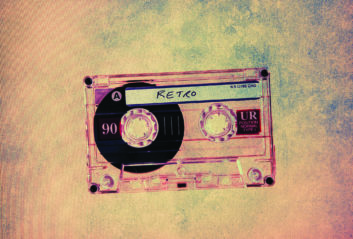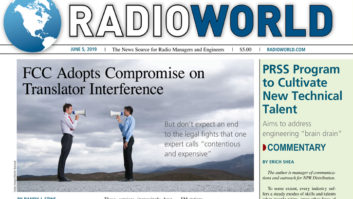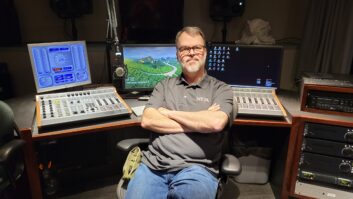
This year will mark my 43rd year in broadcasting. I, like many of our fellow broadcasters, have been in and out of the biz on several occasions.
I recently began writing and telling stories to friends and family about broadcasting and the ups and downs. I substitute teach in a local school district and broadcast high school sports. Obviously, when I teach, the subject of broadcasting comes up.
I am sad to say, but I have to be honest with young people by telling them there appears to be no future in broadcasting. The FCC, satellite, corporate ownership and automation have almost put the final nail in its coffin.
When I first sat in front of a mic there were still plenty of mom-and-pop operations.
Automation was basically still a future thing. The closest techniques to automation (that I witnessed) were Instacarts and reel-to-reel tape with hours of music recorded. The stations where I worked used the tapes so the jock could get long bathroom and smoke breaks. Cart machines were not used for music.
[What Is Radio’s Value in 2019 and Beyond?]
Jocks were busy in a control room, taking meter readings, delivering live commercials, PSAs and liners. Jocks generally had to keep a keen eye on the turntables for scratches in the vinyl and a bad stylus or cartridge. Strangely enough, we didn’t call an engineer to fix a turntable; we did it ourselves. Same with lights on the board, drive wheels on cart machines and the forever squeaky carousel cart rack.
Today, with only a few exceptions, we get to hear the very mechanical voice of someone sitting in a sterile control room who is totally clueless about broadcasting. Most appear to be rather brainless and without any talent.
I am an avid radio listener to local radio, and I DX a lot. DXing on the AM band is all but gone now. I am in northwest Arizona, and “back in the day” KOMA, KOA, KSL, WWL, KRLD, KVOO and a few others boomed into the area, no more. KSL and KOA still manage to make the trip but not with the clarity of past years.
DISMAL AT BEST
Local radio here is dismal at its best. All of the stations are owned by two separate corporations. Now, don’t get me wrong; I am a capitalist and believe in the dollar. I have managed and owned stations and know what has to be done to make the “nut.”
Over the years I have automated stations, but have never fully automated a station. I still believe we serve in the public interest and are the first line for news and weather.
Out of the 15 or so stations here, it is probably safe to say that 95% of the broadcast day is satellite. Live news is minimal and is delivered in the rip-and-read format (plagiarized from the local newspapers). There is not a radio news person at any of the stations.
Weather is the saddest of all. We recently experienced a crippling snowstorm. Not a peep from any of the stations. I called one station and questioned why weather, road, electrical outage and shelter reports were not being aired. You’ll love this. The answer was, “Oh, we’re satellite and only sell advertising.” Welcome to corporate ownership.
FM EXODUS
I am still angry at the commission for allowing AM and FM stations to split. This caused a mass exodus of, primarily, FMs to leave their original city of license and head for what would become an overcrowded metro area. The corporations have the FCC in their back pockets, make no mistake about it. No logical thinking human would allow so many small towns to lose their stations.
Okay, I’m ready for the backlash. “We had to move because the market dried up, and we couldn’t make it.” I find that a lame excuse. Corporations paid huge amounts of money for licenses they knew their attorneys could move and upgrade and ultimately sell the license for a massive profit. Wave enough money in front of a fool, and they’ll jump at it every time.
I know, however, there were many stations sold due to the owner(s) getting old or dying — excuse accepted.
[AFRTS Enthusiast Seeks to Help Preserve the Past]
I enjoy telling students about the good old days, spinning records, taking music requests, talking with the listener, and if you were comfortable with the listener, putting them on the air. I remember lowering power at an AM and then putting on a long record then running to the tuning shack to change the tower pattern. In a rain storm that was a real treat. “American Pie” and “In-A-Gadda-Da-Vida” were popular for pattern change.
Now, if you contact the commission with a solid plan for a low-power FM in a small city, the answer is usually: “The market is already overcrowded and a new frequency is not available.” This, for the most part, is hogwash.
The commission simply is not as interested in radio as they were before the early ’70s.
It is also widely known the corporations will fight any new license tooth and nail. The corporations actually have a monopoly on radio broadcasting.
REMOTE MEMORIES
I enjoy speaking with youngsters about radio. Their eyes actually light up when I tell them about the shenanigans we pulled at remotes: Sitting in a horse trough full of cherry Jell-O (That stuff stains the skin!). Sitting in the basket of a 100-foot crane hanging over a car dealership. Holding 24-hour remotes at businesses. Hogtying pigs in a muddy rodeo arena. Pushing Oreo cookies down the long corridor of a shopping mall with our noses. And of course, no remote résumé would be complete without a good donkey softball game.
One time, I ran more than 150 feet of Belden wire from a woman’s house so I could broadcast a six-man football game in the Texas panhandle. The field was lighted with car headlamps. The best thing was that we won.
Students find it almost unimaginable that these remotes were done without a cell phone.
[NAB: Time to Look Closely at All-Digital AM HD Radio]
I honestly miss those days, when radio was king and meant something to a community. Radio stations were the lifeline for news, weather, sports and school closings.
I would stay glued to WKY in Oklahoma City and anxiously wait for Danny Williams to tell us school was out for bad weather. We all knew Williams, Dale Wheba, Johnny Dark, Charlie Tuna and several others who kept us entertained on Oklahoma City radio stations WKY, KOMA and KOCY.
At night, I could listen to the big names out of WLS, WWL and KXOK. And who could forget the 250,000 watt flamethrower in Mexico with Wolfman Jack?
Radio was much better back then. We could have cared less about a little static; that was part of listening, as was jumping in the car and pushing the radio buttons to hear our favorite song or jock.
I guess if I live long enough and hit the lottery I will buy another station in some small city and bring back old-time radio. If I pay the bills and make a few bucks, that will be just fine. I think I would find a location where the station was stolen by some glutinous corporation and then buy the license back and move the station back to its home.
Wishful thinking…







